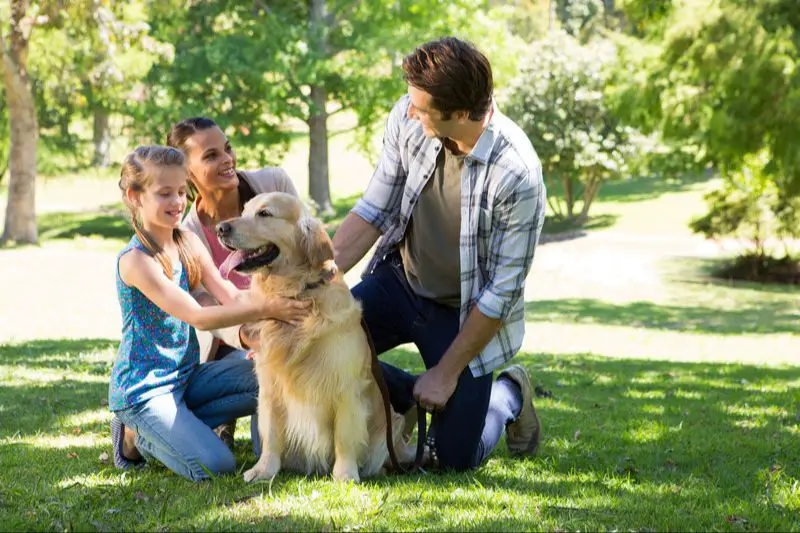Introduction
How complex are a dog’s thoughts? This is a question many dog owners think about. Dogs clearly have emotions and problem-solving abilities, but the extent of their inner mental lives remains mysterious. In this article, we will explore what science has revealed so far about the cognitive capabilities of dogs.
Specifically, we will look at dogs’ brain structure, senses, social cognition, emotion, memory, communication skills, and problem-solving abilities. We will synthesize the latest research to shed light on the scope and complexity of dogs’ inner worlds. By better understanding how dogs think, we can improve our relationships and care for our canine companions.
Brain Structure
Dogs have smaller brains than humans, but larger brains compared to other animals of similar size. The average brain size for an adult dog is around 100 grams, while the average adult human brain is around 1300-1400 grams. Despite the size difference, the structure of the dog brain shares many similarities with humans and other mammals.
Like humans, a dog’s brain features an enlarged cerebral cortex, the outer part of the brain involved in higher-order thinking. However, the cerebral cortex makes up less than 40% of a dog’s brain compared to 80% of the human brain. Dogs also have a decreased number of cortical neurons and convolutions compared to humans and other primates.
Interestingly, dogs have around twice the number of neurons in their cerebral cortex compared to cats of a similar size. This suggests dogs may be capable of more complex thoughts and behaviors. Dogs also have a larger olfactory bulb for interpreting smells and a more developed limbic system for regulating emotions.
Compared to their wolf ancestors, domestic dogs have smaller brains with less cortical neurons and a reduced olfactory center. This likely reflects dogs’ adaptation to life alongside humans, relying less on smell and independent decision making. But their brain anatomy still allows for advanced social cognition compared to many domesticated species.
Senses
Dogs have an incredibly advanced sense of smell that dwarfs that of humans. Their long snouts and moist noses house up to 300 million olfactory receptors, whereas humans have just 6 million. This allows dogs to detect odors at concentrations of 1 part per trillion, equivalent to detecting a single drop of scent in an Olympic-sized swimming pool. Dogs primarily use their sense of smell to perceive the world, determine location, identify other animals, detect danger, and communicate.
In addition to their amazing sense of smell, dogs have excellent hearing capabilities. Their movable outer ears can pinpoint the location of sounds, and they can hear frequencies between 67-45,000 Hz, compared to 64-23,000 Hz in humans. This allows dogs to hear higher pitched sounds at 4 times the distance of humans. Dogs primarily use their sense of hearing to detect prey, perceive threats, comprehend human speech, and analyze toy squeaks.
While less relied upon than smell and hearing, dogs have decent vision as well. They see color, though not as vividly as humans. Their eyes detect motion adeptly, allowing them to spot small movements at distances up to one mile. Dogs have better night vision and peripheral vision than humans. Their visual abilities aid in facial recognition, interpreting body language, locating toys, catching treats, and more.
In summary, dogs have extremely advanced sensory capabilities, particularly smell and hearing. Their senses provide a richer perceptual experience of the world than humans enjoy. Dogs rely heavily on sensory information to understand their environment and interact with it in complex ways.
Social Cognition
Dogs have demonstrated an impressive ability to understand and respond to human social cues. This includes interpreting pointing gestures, following a person’s gaze, and reading human body language and facial expressions. Researchers believe this is possible because dogs have evolved specific skills for interacting with humans.

One key experiment showed that dogs are able to follow human pointing and gestures, even for indirect indications like nods, glances, and bows. Puppies as young as 6 weeks old are able to follow a pointed finger to find a hidden treat. This skill likely emerged through domestication, as wolves do not understand human social cues in the same way.
Experts theorize dogs gained a “theory of mind” during evolution, allowing them to perceive humans as intentional agents with their own beliefs and goals. This means dogs can pick up on what humans are paying attention to, intending to do, or wanting them to do. Dogs are one of the few species with this capability.
Overall, research indicates dogs have highly advanced social cognition abilities when it comes to interacting with humans. Their interspecies communication skills are unmatched in the animal kingdom.
Emotion
Dogs appear to experience a range of complex emotions including jealousy, empathy, fear, anxiety, grief, joy, curiosity, and love. Studies have found that dogs demonstrate signs of basic and complex emotions through behavioral and physiological reactions. For example, when dogs feel jealousy or envy, they may become aggressive or attention-seeking. Dogs are also capable of empathy and appear to understand human emotions. When owners are stressed or cry, dogs often approach them calmly, nuzzle, lick, or sit close to them. This suggests dogs not only recognize human emotions, but respond in an attempt to comfort us.
Research indicates dogs may feel complex social emotions like guilt, pride, shame, and embarrassment. For example, when dogs misbehave and then realize their owners are upset, they often display appeasement behaviors like averting their gaze, hiding, or laying down with their ears back. These signs suggest dogs feel guilt about displeasing their owners. Studies have found dogs demonstrate pride through behaviors like tail wagging when they complete a task and are praised. Some dogs even blush when scolded or praised, suggesting feelings of embarrassment or shame.
Overall, given the complexity of canine emotions and their close connections with humans, many experts believe dogs have rich emotional lives that include higher-level emotions like empathy, jealousy, and grief. However, more research is still needed to fully understand the extent of canine emotional intelligence.
Memory
Dogs have excellent short-term memory and can remember events, people, smells, locations, commands, and experiences. Their short-term or working memory allows them to retain information just long enough to complete a task. For example, dogs can remember where a treat is hidden or the commands to perform a trick.
However, dogs do not have the same episodic memory capacity as humans that allows us to recall personal past experiences. Dogs likely do not have an autobiographical sense of self over time. Instead, their long-term memory is based on associations. They remember events in relation to rewards or punishments, rather than placing events in a sequential timeline.

Experiments show dogs can remember hand signals and words learned up to 5 years ago. Their long-term memories are built through repetition and practice. Dogs excel at remembering faces, smells, locations, daily routines, and learned behaviors that have been reinforced over time.
While dogs may have some sense of the past and anticipation of habitual events like mealtimes, their ability to think about the past or plan for the future is limited compared to humans. Their memory and cognition is focused primarily in the present moment.
Communication
Dogs have a wide range of ways they communicate with each other and with humans. Dog vocalizations like barks, growls, and whines each convey different meanings based on pitch, context, and other factors. For example, short repetitive barks often indicate alarm or excitement, while low growls tend to signal aggression or distrust.

A dog’s body language and facial expressions are also important communication methods. Tail position and movement gives clues into a dog’s mood – upright and wagging usually shows happiness and friendliness while tucked under often signals fear or uncertainty. Ears perked up generally indicate alertness or engagement while flattened ears can mean aggression. Dogs also rely on scent communication via glands and urine/feces marking.
In terms of understanding human communication, studies have shown dogs can learn the meaning of hundreds of words. Simple commands like “sit”, “stay”, and “come” are easily understood, while some dogs can learn the names of toys and understand phrases. Experts believe vocal tone, body language, and hand signals also help dogs interpret human intent.
While we may never fully understand their internal experience, dogs have demonstrated a remarkable ability to understand and communicate across species with humans. Their diverse forms of communication reveal an intelligence and emotional complexity beyond what was previously assumed.
Problem Solving
Dogs display impressive problem solving abilities in their daily lives. When given puzzle toys, dogs will manipulate the toy in different ways using their mouth, paws, body position until they manage to get the treat out. Dogs that go to obedience school also display complex problem solving as they learn how to correctly perform behaviors on cue like sit, stay, come, down. The popular dog tricks that owners teach require dogs to problem solve the connection between the verbal cue, the desired behavior, and the reward. Agility competitions take dogs’ problem solving skills to the highest level as they adeptly navigate obstacles, jumps, ramps, and tunnels in a set course.
A notable example of advanced problem solving in dogs is Chaser, a border collie who learned over 1,000 noun names for different toys through the use of exclusion learning. Her owner would present a group of toys, ask for a specific toy, and reward Chaser once she selected the correct toy through process of elimination. This demonstrates dogs have the cognitive capacity for complex language processing and problem solving.

Conclusion
In summary, dogs possess a remarkable range of cognitive abilities that allow them to perceive, understand, and interact with their environment in sophisticated ways. Their exceptional olfactory capabilities, social cognition, and ability to understand human communication and emotions point to an intelligence adapted for life among people. While dogs cannot use language or engage in abstract thinking like humans, they display many forms of cognition like memory, learning, and problem solving that were once thought limited to people.
There is still much to uncover about canine minds. As research tools improve, scientists continue to gain insights into how dogs think and the neural mechanisms behind their mental processes. Exciting areas for future study include exploring the extent of dogs’ self-awareness, mapping the genetics behind their social intelligence, and determining if and how dogs possess theory of mind. Overall, the depth and breadth of dogs’ cognitive abilities underscores why they make such responsive companions.
While dogs cannot verbalize their inner mental lives, their cognition reveals an animal with perceptions, emotions, and intelligence that deeply resonate with humans. Our understanding of the canine mind continues to evolve, yet it’s clear there’s more going on in the head of man’s best friend than once imagined.
Additional Resources
For readers interested in learning more about dog cognition and behavior, here are some helpful resources:
- Understanding Dog Behavior – American Kennel Club
- The Canine Mind: How Smart are Dogs? – Animal Health Foundation
- Dogs have a higher social intelligence than wolves – ScienceDaily
- How Smart is Your Dog? – Psychology Today
- How Dogs See the World – American Kennel Club
- How Dogs Learn – American Kennel Club
There are also many good books and research papers available on canine cognition, problem solving, and behavior. Consult with your local librarian or search Google Scholar for additional in-depth resources.